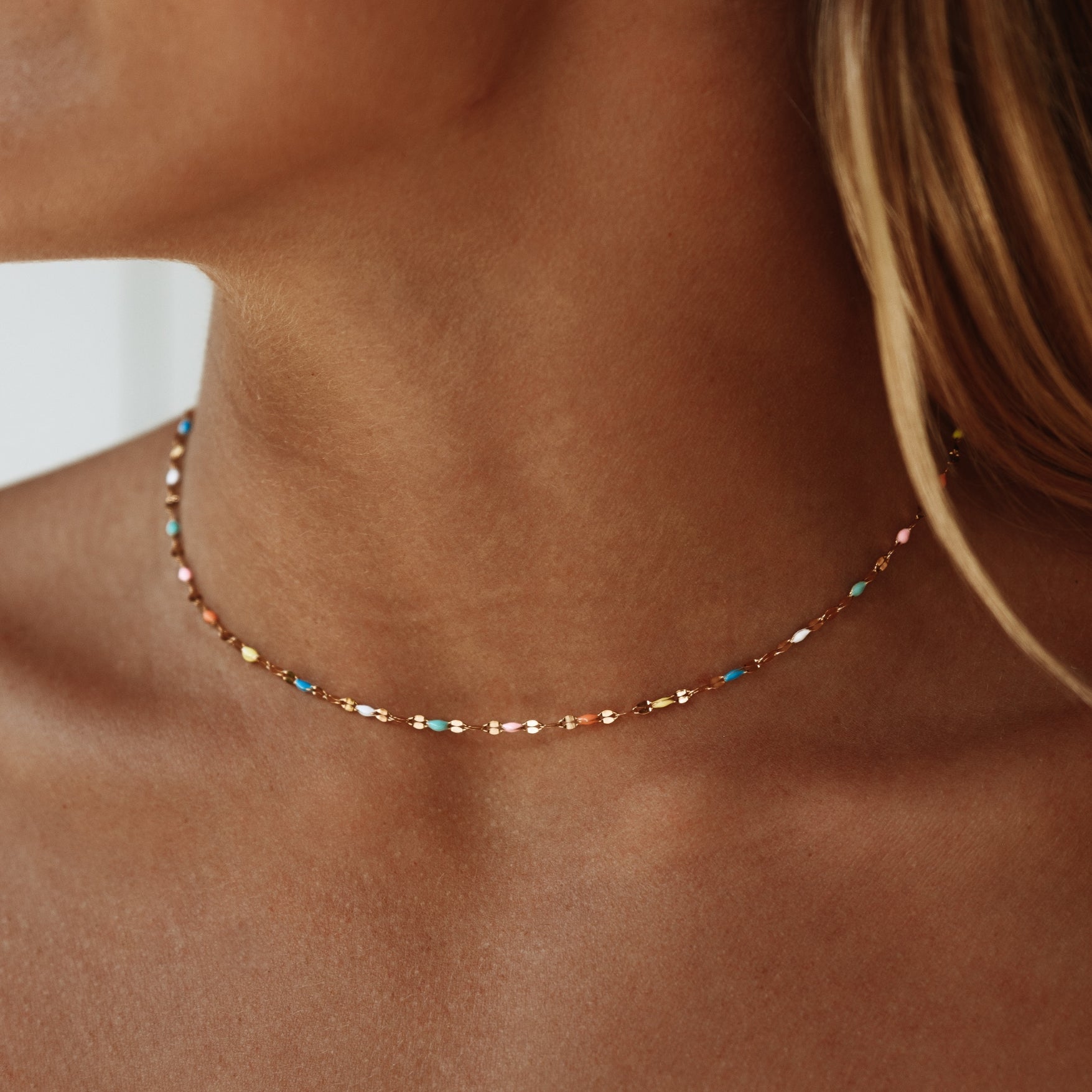
What is 18K Gold Plated Jewelry?
Understanding 18K Gold Plating
Understanding 18K gold plating involves recognizing that a thin layer of 18-karat gold is electrochemically bonded onto the surface of a base metal, providing the appearance and some characteristics of solid gold without the associated cost. This technique leverages the high gold purity of 18K gold, which is composed of 75% pure gold and 25% alloyed metals. The result is a visually appealing and durable finish that mimics the luxurious qualities of solid gold.
When considering 18K gold plated jewelry, it's crucial to understand the significance of plating thickness. Plating thickness directly impacts the durability and longevity of the gold layer. Typical gold plating thickness ranges from 0.5 microns to 2.5 microns. A thicker layer generally offers better resistance to wear and tarnish, thereby extending the life of the jewelry piece.
However, even with the appropriate thickness, the gold layer will eventually wear off due to factors such as friction and exposure to chemicals.
The Gold Plating Process
You'll start with meticulously preparing the base metal to guarantee a flawless adhesion of the gold layer.
The application of the 18K gold layer involves precise electroplating techniques that ensure uniform coverage.
Preparing the Base Metal
Before the gold plating process begins, you need to thoroughly clean the base metal to guarantee optimal adhesion and a flawless finish. The base material, often brass or copper, must undergo meticulous surface preparation to ensure the gold layer adheres properly.
First, remove any oils, grease, or dirt using an ultrasonic cleaner or a solvent solution. This step is essential because contaminants can impede the electrochemical bond between the base material and the gold layer.
Next, perform mechanical polishing to smooth the surface. This involves using abrasive pads or polishing wheels to eliminate any imperfections, scratches, or oxidation that could affect the final appearance and durability.
After polishing, conduct acid cleaning to remove any remaining microscopic particles and oxidation. Typically, you'll immerse the base metal in a diluted acid solution, such as hydrochloric or sulfuric acid, to achieve a pristine surface.
Following this, rinse the piece in distilled water to remove any residual acid.
Applying Gold Layer
To apply the gold layer, immerse the meticulously prepared base metal into a gold plating solution, making sure it's connected to the negative terminal of a power supply to facilitate the electroplating process. This electrochemical reaction deposits a thin layer of gold onto the base metal. The gold thickness is dependent on the duration of immersion and the current density applied during the process.
For best results, you should employ precise coating techniques. Start by adjusting the voltage and current parameters to control the deposition rate. A higher current density typically accelerates gold deposition but can lead to uneven layers, whereas a lower current density ensures a smoother, more uniform coating. Consistency in these parameters is essential to achieving the desired gold thickness.
Monitor the solution's temperature and pH levels as they greatly impact the plating quality. You must also agitate the solution gently to prevent the formation of gas bubbles, which can cause defects in the gold layer.
Ensuring Durability Standards
Guaranteeing the durability of 18K gold plated jewelry involves meticulous adherence to industry standards and rigorous quality control measures. To achieve peak wear resistance, manufacturers employ a multi-step gold plating process. Initially, the base metal undergoes a thorough cleaning to remove contaminants that could impede adhesion.
Next, a preliminary layer, often of nickel, is applied to enhance the bond between the base metal and the gold layer. The gold plating itself must comply with specific thickness requirements, typically measured in microns, to guarantee sufficient coverage and durability. The thickness of the gold layer directly influences the longevity factors, as a thicker layer provides better protection against wear and tear.
Additionally, the electroplating process used to apply the gold layer must be finely controlled. Parameters such as voltage, current density, and plating time are precisely regulated to ensure uniform deposition. Post-plating treatments, like rinsing and drying, are carefully executed to avoid leaving residues that could compromise the jewelry's longevity.
Benefits of 18K Gold Plated Jewelry
When contemplating 18K gold plated jewelry, you'll discover it provides an affordable luxury option without compromising on quality. Its high-quality appearance closely emulates solid gold, making it a desirable choice for numerous occasions.
Additionally, its versatility in fashion guarantees it complements a wide range of styles and outfits.
Affordable Luxury Option
Opting for 18K gold plated jewelry allows you to enjoy the aesthetic appeal of high-quality gold without the hefty price tag. When making a cost comparison, genuine 18K gold is substantially more expensive due to its high gold content. However, 18K gold plated jewelry offers a similar luxurious look but at a fraction of the cost. This makes it an ideal option for those looking to accessorize without making a significant financial investment.
From an investment potential perspective, while 18K gold plated pieces won't appreciate in value like solid gold, they still hold considerable appeal. They provide you with the flexibility to own multiple pieces in various styles, which can be particularly advantageous for keeping up with fashion trends. This versatility ensures you get the most out of your monetary investment without compromising on style.
Additionally, 18K gold plated jewelry's affordability means you can experiment with different designs and settings without the risk associated with high-value items. This makes it a prudent choice for both everyday wear and special occasions.
Ultimately, choosing 18K gold plated jewelry provides a balanced blend of elegance and economic sensibility, making it a smart choice for modern consumers.
High-Quality Appearance
18K gold plated jewelry offers a high-quality appearance that closely mimics the look of solid gold, thanks to advanced plating techniques and meticulous craftsmanship. The process involves electroplating a thin layer of 18K gold onto a base metal, guaranteeing a durable and lustrous finish. This technique secures color consistency, giving the jewelry a uniform and vibrant golden hue that remains stable over time.
The high-quality appearance of 18K gold plated pieces is a significant factor driving their market demand. Consumers are drawn to the elegant and luxurious look that these pieces provide without the exorbitant cost associated with solid gold. The precision in the electroplating process ensures that the gold layer is evenly distributed, enhancing the visual appeal and making it nearly indistinguishable from solid gold jewelry.
Furthermore, the meticulous craftsmanship involved in creating 18K gold plated jewelry includes careful polishing and finishing, which contributes to its sophisticated appearance. This attention to detail guarantees that each piece exhibits a high-quality finish, making it an attractive option for those seeking luxury aesthetics. The result is jewelry that not only meets but often exceeds consumer expectations for elegance and durability.
Versatile Fashion Choice
Beyond boasting a high-quality appearance, gold plated jewelry offers unparalleled versatility, making it a favored choice for a wide range of fashion styles. Whether you're aiming for classic elegance or contemporary chic, 18K gold plated pieces seamlessly integrate into various fashion trends. The adaptability of these accessories guarantees you can effortlessly shift from casual daywear to sophisticated evening ensembles.
Incorporating 18K gold plated jewelry into your wardrobe allows you to stay ahead of evolving fashion trends without committing to the high costs associated with solid gold items. This affordability opens up avenues for experimenting with diverse, versatile styles, enabling you to curate a personalized collection that suits any occasion. Additionally, the durability of the gold plating ensures that your pieces maintain their luster and appeal through regular wear.
The intrinsic versatility of gold plated jewelry also means it complements a wide array of materials and colors, adding an element of refined sophistication to any outfit. Whether paired with a minimalist monochrome ensemble or a vibrant, patterned attire, 18K gold plated jewelry serves as a timeless accessory that enhances your overall aesthetic without overpowering it.
Drawbacks to Consider
When evaluating 18K gold plated jewelry, it's important to take into account potential drawbacks such as durability issues and susceptibility to tarnishing. One significant consideration is the risk of allergies. Gold plating often masks a base metal like nickel, which can cause adverse skin reactions in some individuals. If you have sensitive skin, you might experience itching, redness, or even rashes.
Another critical aspect to keep in mind is color fading. Unlike solid gold, the thin gold layer on plated jewelry can wear off over time, especially with frequent use. This can lead to the underlying metal becoming exposed, resulting in an unattractive appearance. Regular contact with water, sweat, or chemicals can accelerate this process, further diminishing the jewelry's aesthetic value.
Durability is another issue. The gold plating is generally very thin, making it susceptible to scratches and dents. Daily wear and tear can quickly degrade its appearance, necessitating frequent re-plating to maintain its look.
Additionally, tarnishing is a common problem. The base metals can react with air and moisture, leading to discoloration and corrosion, which further compromises the jewelry's visual appeal and longevity. Considering these factors is important before making a purchase decision.
Tips for Maintenance
To maintain the luster and longevity of your 18K gold plated jewelry, you should follow a few essential care practices. First and foremost, establish a consistent cleaning routine. Use a soft, lint-free cloth to gently wipe your jewelry after each use to remove oils and residues.
For a deeper clean, immerse the jewelry in lukewarm water mixed with mild dish soap. Use a soft-bristle toothbrush to delicately scrub the surface, then rinse with cool water and pat dry with a clean cloth.
Proper storage is equally critical. Store your 18K gold plated pieces separately to avoid scratches and tarnish. Utilize anti-tarnish pouches or cloth-lined jewelry boxes. Ensure each piece is stored in a dry, cool environment, away from direct sunlight and humidity which can accelerate tarnishing.
Additionally, avoid exposure to harsh chemicals and abrasives. Remove your jewelry before swimming, exercising, or applying lotions and perfumes. These substances can erode the gold plating and dull its appearance.
Choosing Quality 18K Gold Plated Pieces
Selecting quality 18K gold plated jewelry requires a keen eye for craftsmanship and an understanding of the materials used in the plating process. First, examine the base metal—common choices include brass, sterling silver, or stainless steel. This will impact durability and overall appearance. High-quality pieces will have a thicker layer of 18K gold, typically measured in microns. Aim for at least 2.5 microns for lasting wear.
To guarantee authenticity and durability, look for certification standards such as ISO or ASTM marks, which indicate compliance with recognized industry guidelines. These certifications can validate that the piece meets stringent quality and safety regulations.
Staying updated with current fashion trends can also guide your selection. Popular styles often feature intricate designs and advanced plating techniques that enhance longevity and aesthetic appeal. Pay attention to the craftsmanship; well-made jewelry will have smooth, even plating without visible flaws or discoloration.
Lastly, consider the reputation of the jeweler. Established brands are more likely to adhere to high standards and offer warranties, providing peace of mind. By focusing on these factors, you can confidently choose 18K gold plated pieces that combine elegance, durability, and contemporary style.
Conclusion
To summarize, when examining 18K gold plated jewelry, it's crucial to understand its composition, the intricate plating process, and its benefits like affordability and aesthetic appeal.
However, it's important to take into account drawbacks such as potential wear over time. When comparing it to solid gold, the cost-effectiveness stands out, although longevity may differ.
Regular maintenance will prolong its life. By selecting high-quality pieces, you'll enjoy the elegance of gold without the hefty price tag.
























Leave a comment
This site is protected by hCaptcha and the hCaptcha Privacy Policy and Terms of Service apply.